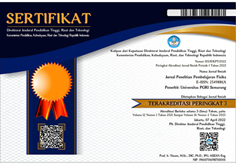Virtual Reality Effect on Student Learning Outcomes in Nuclear Physics and Radioactivity Topics
DOI:
https://doi.org/10.26877/jp2f.v16i4.2832Keywords:
virtual reality, learning outcomes, nuclear physics, radioactivityAbstract
Learning Nuclear Physics and Radioactivity is often perceived as difficult by student because the concepts are abstract, thus requiring learning media that can visualize these concepts more concretely. This study aims to analyze the effect of using Virtual Reality media on student’s learning outcomes in the topic of Nuclear Physics and Radioactivity. The research employed a Quasi Experimental method with a Nonequivalent Control Group Design. The subject were 33 12th grade students of Al Adzkar High School, divided into two groups: an experimental group and a control group. The research instrument consisted of 20 multiple-choice questions mesuaring cognitive abilities from levels C2 to C6. The result indicated a significant difference between the control and experimental groups. The average post-test score of students in the experimental class (76.47) was higher than that of the control class (69.06). Improvement in learning outcomes was also reflected in the N-Gain score, which reached 0.57 (medium category) for the experimental class and 0.38 (medium category) for the control class. The analysis of cognitive indicators showed that improvement in the experimental class was more evenly distributed compared to the control class. Therefore, the use of Virtual Reality has been proven to enhance students learning outcomes by providing a more interactive and engaging learning experience, making it a potential alternative medium for classroom instruction.
References
[1] Villada Castillo J F, Bohorquez Santiago L and Martínez García S 2025 Optimization of Physics Learning Through Immersive Virtual Reality: A Study on the Efficacy of Serious Games Applied Sciences (Switzerland) 15
[2] Suparya I K, I Wayan Suastra and Putu Arnyana I B 2022 Rendahnya Literasi Sains: Faktor Penyebab Dan Alternatif Solusinya Jurnal Ilmiah Pendidikan Citra Bakti 9 153–66
[3] Mufit F, Dhanil M and Hendriyani Y 2025 Development of Quantum Physics Laboratory Based on Immersive Virtual Reality International Journal on Informatics Visualization 9 342–50
[4] Rizal R, Ridwan I M, Suhendi H Y and Mahmudah I R 2025 Student’s Readiness in Using Virtual Reality for Physics Learning Journal of Teaching and Learning 19 131–54
[5] Morales López A I and Tuzón Marco P 2022 Misconceptions, Knowledge, and Attitudes Towards the Phenomenon of Radioactivity Science and Education 31 405–26
[6] Kriswahyudi B 2020 Meningkatkan Kemampuan Menganalisis Karakteristik Inti Atom , Radioaktivitas, dan Pemanfaatannya Dalam Kehidupan Sehari-hari Menggunakan Model Pembelajaran Jigsaw Pada Peserta Didik Kelas XII MIPA 1 SMAN 1 CIBEBER Prosiding Seminar Nasional Sains 1 75–84
[7] Maulana S R, Ronggowulan L, Studi P, Geografi P, Keguruan F, Maret U S, Aktivitas T, Siswa B and Xi K 2024 Pengaruh Media Pembelajaran Virtual Reality Terhadap Aktivitas dan Hasil Belajar Siswa Kelas XI di SMAN 1 121–32
[8] Bogar D Y, Jufriansah A and Prasetyo E 2023 Pengembangan Laboratorium Virtual untuk Meningkatkan Hasil Belajar Peserta Didik Buletin Edukasi Indonesia 2 102–12
[9] Bezen S 2024 Radiation knowledge and awareness : Evaluation from the perspective of high school students 01020
[10] Hendajani F, Hakim A, Sudiro S A, Saputra G E and Ramadhana A P 2019 Tracking Visualization of 3 Dimensional Object Natural Science Learning Media in Elementary School with Markerless Augmented Reality Based on Android Journal of Physics: Conference Series 1192
[11] Budi A S, Sumardani D, Muliyati D, Bakri F, Chiu P-S, Mutoharoh M and Siahaan M 2021 Virtual Reality Technology in Physics Learning: Possibility, Trend, and Tools Jurnal Penelitian & Pengembangan Pendidikan Fisika 7 23–34
[12] Salihu ahmed and Sabitu Abdulmalik 2024 Issues and Ideas in Education CHITKARA 12 14–8
[13] Sugiyono 2013 Metodologi Penelitian Kuantitatif, Kualitatif dan R & D (Bandung: Penerbit Alfabeta)
[14] Budiastuti Dyah dan Bandur Agustinus 2018 Validitas dan Reliabilitas Penelitian Dilengkapi Analisis dengan NVIVO, SPSS dan AMOS (Jakarta: Penerbit Mitra Wacana Media)
[15] Suwarna, Iwan dan Ilmi D 2016 Pengembangan Instrumen Ujian Komprehensif Mahasiswa
[16] Suci E and Kusumawati A 2024 RODA : Jurnal Pendidikan dan Teknologi Otomotif Meta Analisis : Pengaruh Penggunaan Media Pembelajaran Virtual Reality terhadap Hasil Belajar 4 24–8
[17] Nisa A and Dwiningsih K 2022 Analisis Hasil Belajar Peserta Didik Melalui Media Visualisasi Geometri Molekul Berbasis Mobile Virtual Reality (MVR) PENDIPA Journal of Science Education 6 135–42
[18] Dhanil M and Mufit F 2024 How Virtual Reality Impacts Science Learning? A Meta-Analysis International Journal of Interactive Mobile Technologies 18 77–96
[19] Tarng W and Pei M C 2023 Application of Virtual Reality in Learning Quantum Mechanics Applied Sciences (Switzerland) 13
[20] Tene T, Bonilla García N, Coello-Fiallos D, Borja M and Vacacela Gomez C 2024 A systematic review of immersive educational technologies in medical physics and radiation physics Frontiers in Medicine 11 1–18





